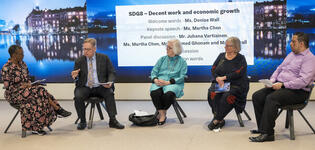Blog
Want to catch up on UNU-WIDER research? Here are 10 of the most interesting papers published over the last year
In this blog, the managing editor of the WIDERAngle shares his personal view on some of the most important —and potentially overlooked— work recently released in the WIDER Working Paper Series.
We just passed the halfway point of 2022 and, as of this writing, UNU-WIDER has already released 70 working papers this year. In 2021, the series published 190 papers. Many of these go on to be published in major academic journals.
As the managing editor of UNU-WIDER’s blog and newsletter, it is my job to select the small handful of working papers that are shared with the network every month through our WIDERAngle newsletter. We highlight at least 90 papers a year, but this is only roughly half the papers we release annually.
So, how can you decide which papers to engage with, and why? Here are several of my favorite recent working papers from UNU-WIDER’s catalogue and why I think they are important.
1. Underprivileged groups
Several papers examine outcomes for historically underprivileged groups —too many to mention here. One of these is an outgrowth of a journal special issue, on outcomes for forced migrants in host countries that is a closer look at why migrants from Viet Nam, overall, had better outcomes than migrants from Afghanistan. The authors propose the answer partly lies in ‘securitized reception’ —how international security policy influences the way that migrants are received— an understudied area of migration policy.
2. Global inequality and the very rich
The income and wealth inequality most people care about is the inequality between the bottom and the top of the distribution, or the middle and the top. That champagne fountains are erected on luxury yachts while millions go hungry —or that median wage workers struggle to buy gas while CEOs take record bonuses— is too much of an injustice for most of us to agree to.
Yet, as inequality experts slowly fill in the details about the very top incomes, one thing to notice is that the starkest inequality is sometimes between the top 1%, the top .01%, and the top .001%. This paper is important because it takes a first look at tax register data in Uganda and fills a standard knowledge gap about top incomes (the highest income earners are notorious for underreporting their incomes in survey data). And, it tells us something new about elite inequalities in a low-income African country.
3. A boomerang effect
If you want to understand the confusing narratives on the historical trend in global inequality, read this paper which also predicts the future of global inequality to 2040. It argues that global inequality fell but will now likely reverse course —like a boomerang— and maybe come right back up to pre-1980 levels.
Global income inequality fell considerably and near constantly since 1980, but this fall represents the rise of China and India —the two most populous countries in the world— from the lowest ranking by per capita income. Now that both are approaching the global median, future growth in these economies will increase global inequality —rather than decrease it— as they join the top half of the distribution. As the authors put it:
‘The decline in global inequality over the last decades has spurred a “sunshine” narrative of falling global inequality that has been rather oversold, in the sense, we argue, it is likely to be temporary’.
4. Can we grow our way to equality?
I also recommend this comprehensive review of the relationship between economic growth and inequality. The upshot, economics still doesn’t have any idea what the relationship is. My own theory is simple, it depends on the trend for the capital share, mediated by private debt levels. While it’s a surprise to me that there are still so many gaps in the knowledge base, this paper is a great point of departure for what is called ‘a great open debate’ in the title. It might inspire you to write your own version of Thomas Piketty.
5. Oil theft and 6. fuel riots
Several papers in our series look at problems in the oil and gas industry and what the impacts are on developing economies with large reserves. Two related papers draw attention to a unique issue —global oil theft— which accounts for 5–7% of all crude oil and refined fuels produced. It turns out, oil is the world’s most commonly stolen natural resource and stolen oil deprives developing economies of tax and other revenues. Global oil theft is estimated at US$133 billion per annum.
Another study looks at the association between fuel subsidies and fuel riots, with a surprising finding. Countries with fuel subsidies —which should lower fuel prices— are more likely, not less, to experience fuel riots. The authors postulate that this is because subsidies tend to be unsustainable. When governments are forced to revise or abandon them, the associated fuel price increases are bigger and faster, generating a greater potential for unrest.
7. The gender gap in employment
An incredible paper that deserves more attention for both its empirical and analytical chops combines household survey data from 12 low- and middle-income countries with geospatial data on population density to examine gender gaps across developing countries in access to formal, waged, off-farm employment. Aside from the major contribution in empirical work, it’s the analytics that stand out. The authors use the geospatial data to analyse how regional connectivity (from rural to peri-urban to urban centres) interacts with the known factors which contribute to a woman’s likelihood to have formal employment, such as marital status, child dependency, and level of education. It’s a smart approach that is uniquely suited to the more highly segmented economies studied.
8. Policy reforms can have big effects on women’s autonomy
An Indian reform to equalize access to inheritance rights between men and women has some interesting side effects for gender equality. Despite the fact that the reform only narrowly advanced women’s rights, enabling daughters to receive inheritance, it had broader effects on women’s autonomy in the home. This study finds that women exposed to the reform increased time spent in formal work by 69% and did not reduce leisure time to do so. Instead, other household members made up for their reduced time spent on domestic responsibilities.
9. The role of mothers
Another novel look at gender gaps is a paper that compares children’s education and health outcomes to maternal employment in Indonesia. On one front, the paper answers the question as to whether it is better for children to have an employed mother, or a mother at home to support their early development. In this case, an employed mother leads to better outcomes. But, the real reason I highlight this paper is because it focuses on mothers’ contributions to children’s social mobility —instead of fathers’— which is still rare in the field of intergenerational social mobility.
10. For macro nerds
In January, we published a working paper on South Africa’s macroeconomic challenges lead authored by the highly regarded economist Ricardo Hausmann, with colleagues at the Harvard Growth Lab.
South Africa is one of the most interesting economies in the world to study. Just before the COVID-19 pandemic struck, the country struggled to keep the confidence of international bond ratings agencies. Several commentators thought the odds of a sovereign debt crisis were good. The level of economic literacy is especially high in South Africa, so national debates raged over the role of the central bank, if fiscal consolidation is possible without abandonment of inequality reduction targets, and —especially relevant to South Africa— how policy can help solve the myriad microeconomic paradoxes that seem to plague the economy.
Then COVID-19 happened, slowing the economy further and pushing up government debt —but not without a silver lining for the large demographic of lower-income, working-age South Africans who were suddenly eligible for social transfers for the first time. What remains to be seen is if the country can recover from the COVID-19 fallout and achieve fiscal sustainability. To help think constructively about that question, I suggest this contribution from one of the most respected names in economics today.
To stay up-to-date on UNU-WIDER research, click here to join the network and subscribe to our electronic newsletter.
Timothy Shipp is a Communications Associate at UNU-WIDER with a focus on inequality research. He is the managing editor of the WIDERAngle and holds a Master’s Degree in Global Development Policy from Boston University.
The views expressed in this piece are those of the authors, and do not necessarily reflect the views of the Institute or the United Nations University, nor the programme/project donors
 Join the network
Join the network










